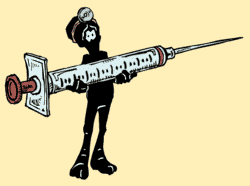 Trials have now been underway for some time on a vaccine designed to reduce the prevalence of malaria in children. Previous tests showed a measurable reduction in malaria in children aged 5 to 17 when treated with the vaccine. Unfortunately, however, the latest tests on babies aged 3 to 4 months have shown a lower degree of efficacy. It is still possible that a combination of bed nets and vaccines could prove an effective weapon against malaria.
Trials have now been underway for some time on a vaccine designed to reduce the prevalence of malaria in children. Previous tests showed a measurable reduction in malaria in children aged 5 to 17 when treated with the vaccine. Unfortunately, however, the latest tests on babies aged 3 to 4 months have shown a lower degree of efficacy. It is still possible that a combination of bed nets and vaccines could prove an effective weapon against malaria.
The majority of the more than half-million people who die of malaria each year in sub-Saharan Africa are children aged under 5. At any given time around 200 million people in the world have malaria – most of them in Africa – and the majority of people living in sub-Saharan Africa are at risk of contracting the disease. The greatest number of malaria victims are in Nigeria and the Democratic Republic of Congo.
According to calculations made by the Institute of Security Studies, the eradication of malaria would contribute $430 billion to Africa’s economy by 2050. On the other hand, according to World Health Organisation estimates, it would cost $5.1 billion per year from now until 2020 to achieve current malaria control targets. Thus there are enormous potential human and financial benefits, but also very significant up-front costs.